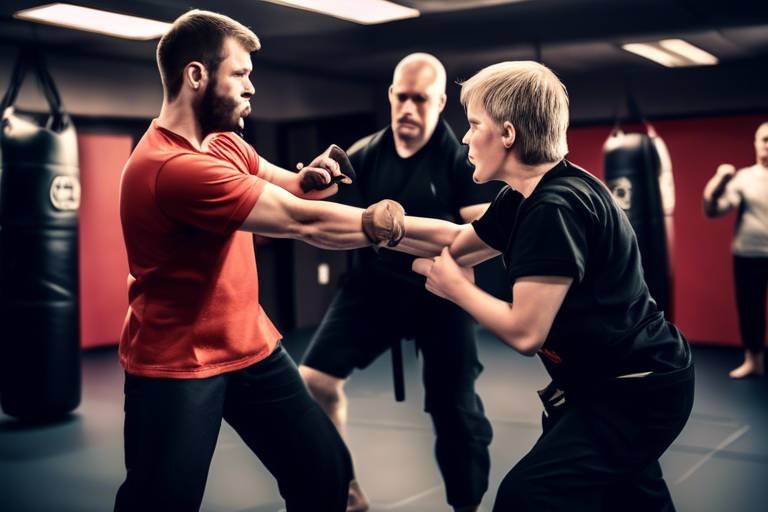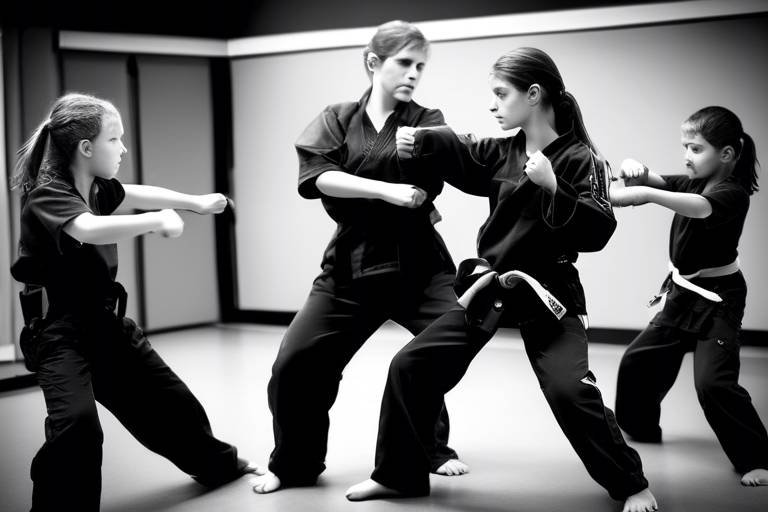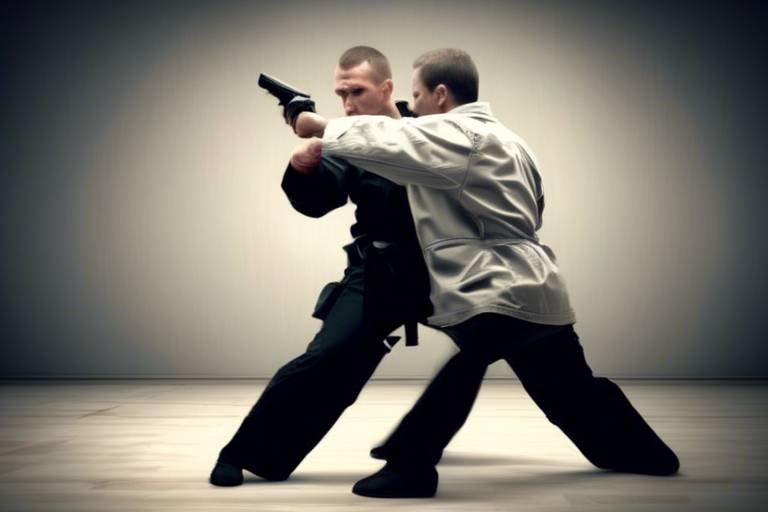Five Non-Lethal Self-Defense Techniques You Should Know
In a world where personal safety is becoming increasingly important, knowing how to defend yourself without causing permanent harm is a valuable skill. This article explores five effective non-lethal self-defense techniques that can be used in various situations to protect yourself and others. These techniques are designed to incapacitate an attacker momentarily while ensuring that they do not suffer lasting injuries. Whether you are walking home late at night or simply want to feel more secure in your daily life, these methods can empower you to handle threatening situations with confidence.
Non-lethal self-defense techniques are grounded in the philosophy of prioritizing personal safety while minimizing harm to attackers. In today’s society, where violence can escalate quickly, having the ability to defend oneself without resorting to lethal force is not just prudent—it’s essential. The rise in awareness around self-defense has led to a greater emphasis on techniques that allow individuals to protect themselves and escape potentially dangerous situations without inflicting permanent damage. This approach not only enhances personal safety but also aligns with ethical considerations, making it a responsible choice for those seeking to empower themselves.
The palm strike is a powerful technique that allows you to deliver a strong blow without the risk of injuring your hands, which can happen when using a fist. The mechanics of a palm strike involve using the heel of your palm to strike an opponent's face or body, targeting sensitive areas such as the nose or chin. This technique is particularly effective in situations where you need a quick and decisive response. Imagine being cornered by an aggressor; a well-placed palm strike can create the necessary space for you to escape. Remember, the goal is to incapacitate long enough to get away safely.
The knee strike is another highly effective non-lethal technique, especially in close-quarters confrontations. By driving your knee into an attacker's groin or stomach, you can incapacitate them momentarily, allowing you to escape. To execute this technique correctly, it’s important to maintain your balance and deliver the strike with force. Think of it as a sudden burst of energy that can turn the tables in a confrontation. It’s a move that can be practiced easily, and once mastered, it can be a game-changer in self-defense situations.
The elbow strike is a versatile and powerful move that can be utilized in various situations, especially when you find yourself in close proximity to an attacker. It involves using the point of your elbow to strike vulnerable areas such as the jaw, ribs, or solar plexus. This technique is particularly useful in self-defense because it allows for quick, unexpected strikes that can catch an assailant off guard. Picture yourself in a tight spot; a swift elbow strike can create the necessary opportunity to break free and escape. It’s all about using your body’s natural weapons effectively.
Knowing how to escape an aggressive hold is crucial for personal safety. Escape maneuvers can help you regain control in threatening situations. One common technique involves using your body weight and leverage to break free from wrist grabs or bear hugs. For instance, if someone grabs your wrist, you can twist your arm towards their thumb, which is the weakest part of their grip. This technique emphasizes the importance of remaining calm and focused, allowing you to think clearly even in high-pressure situations. Mastering escape maneuvers can significantly enhance your confidence in self-defense scenarios.
Joint locks are effective for immobilizing an attacker without causing permanent damage. These techniques involve manipulating an opponent’s joints to restrict their movement, often leading to a position of control. Different types of joint locks can be applied depending on the situation, such as wrist locks or arm locks. Imagine being able to neutralize a threat simply by using their own strength against them; that’s the beauty of joint locks. They not only provide an avenue for self-defense but also showcase the art of control rather than aggression.
Understanding your surroundings is vital for effective self-defense. Situational awareness involves being conscious of the people and environment around you, allowing you to anticipate potential threats before they escalate. This skill can be honed through practice, such as observing your surroundings while walking or being mindful of exits in a crowded place. By staying alert, you can often avoid confrontations altogether, making it a crucial component of personal safety. Think of it as having a sixth sense that helps you navigate through life with confidence.
Self-defense laws vary by location, making it essential to understand the legal implications of using non-lethal techniques. Knowing when and how you can legally defend yourself can prevent complications down the road. It’s advisable to familiarize yourself with local laws regarding self-defense, as well as the concept of proportionality—ensuring your response is appropriate to the threat faced. This knowledge not only protects you legally but also reinforces the importance of using self-defense techniques responsibly.
Regular training is crucial for mastering non-lethal self-defense techniques. Finding the right training resources, whether through classes or online tutorials, can significantly enhance your skills. The importance of practice cannot be overstated; the more you train, the more instinctive these techniques will become. Consider joining a local self-defense group or martial arts class to build your confidence and competence. Remember, self-defense is not just about knowing techniques—it’s about being prepared to use them when it matters most.
- What are non-lethal self-defense techniques? Non-lethal self-defense techniques are methods designed to incapacitate an attacker temporarily without causing permanent harm.
- Why should I learn non-lethal self-defense? Learning these techniques empowers you to protect yourself effectively while minimizing the risk of serious injury to yourself or others.
- How can I practice these techniques? Regular training through classes, online resources, or practice with a partner can help you become proficient in these techniques.
- Are there legal risks associated with self-defense? Yes, self-defense laws vary by location, so it’s important to understand the legal implications of using force in your area.

Understanding Non-Lethal Self-Defense
In a world where personal safety is of utmost importance, the concept of non-lethal self-defense has gained significant traction. These techniques are designed not only to protect oneself from harm but also to minimize the risk of causing serious injury to an attacker. Imagine being in a situation where you need to defend yourself; the last thing you want is to escalate the conflict further. This is where non-lethal methods shine. They prioritize your safety while maintaining a level of restraint that is often necessary in today’s society.
The philosophy behind non-lethal self-defense is rooted in the idea that self-protection should not come at the cost of another person's life or well-being. This approach is especially relevant in urban settings, where confrontations can arise unexpectedly. The goal is to incapacitate an assailant enough to escape, rather than to inflict permanent harm. In fact, many self-defense experts advocate for using techniques that allow you to disengage from a potentially dangerous situation quickly.
As we delve deeper into the realm of non-lethal self-defense, it's essential to recognize the various scenarios in which these techniques can be applied. For instance, a sudden attack in a crowded area, a confrontation with an aggressive individual, or even a situation where you feel threatened by someone’s presence can all benefit from these methods. By understanding the context and environment, you can better prepare yourself to respond effectively.
Moreover, the advantages of mastering non-lethal self-defense techniques extend beyond physical confrontations. They can also enhance your confidence and awareness of your surroundings. When you know you have the skills to defend yourself, you are likely to walk with a sense of assurance. This confidence can deter potential aggressors, as they often target individuals who appear vulnerable. In many ways, being prepared acts as a shield against violence.
In conclusion, understanding non-lethal self-defense is not just about learning a set of techniques; it's about adopting a mindset that values personal safety while respecting the lives of others. As we explore specific techniques in the following sections, keep in mind that the ultimate goal is to protect yourself and escape dangerous situations without resorting to unnecessary violence.

Technique 1: The Palm Strike
The palm strike is a dynamic and powerful self-defense technique that can be a game changer in a threatening situation. Unlike punches that can risk injuring your knuckles or fingers, the palm strike allows you to deliver a strong blow using the base of your palm, which is much more resilient. Imagine the force of a hammer hitting a nail; that’s the kind of impact you can generate with a well-executed palm strike. It’s straightforward, effective, and doesn’t require extensive training to master.
To perform a palm strike, you want to keep your fingers relaxed and your palm flat. The ideal target areas are the nose, chin, or jaw of your assailant. Striking these areas can create enough shock to disorient your attacker, giving you a chance to escape. It’s essential to focus on your body mechanics; use your legs and hips to generate power, rather than just your arms. This technique is particularly useful in situations where you find yourself in close proximity to an aggressor, as it requires minimal space to execute.
Here’s a quick breakdown of when and how to use the palm strike effectively:
- When to Use: If you’re cornered or grabbed, the palm strike can create a moment of surprise, allowing you to break free.
- How to Execute: Stand firm, pivot your hips, and thrust your palm forward towards the target. Aim for a quick, explosive movement.
- Follow Up: After delivering the strike, be ready to either escape or follow up with another technique if necessary.
One of the beauties of the palm strike is its versatility. You can use it as a standalone technique or combine it with other moves for a more comprehensive self-defense strategy. For instance, after striking with your palm, you could follow up with a knee strike to further incapacitate your attacker. It’s all about being fluid and adaptable in your approach.
In a world where personal safety is increasingly paramount, knowing how to effectively use a palm strike can empower you. It’s not just about physical strength; it’s about being smart and strategic. Remember, the goal of self-defense is to escape and protect yourself, not to engage in a prolonged confrontation. The palm strike is an excellent tool in your self-defense arsenal, allowing you to defend yourself without causing permanent harm to your attacker.

Technique 2: The Knee Strike
The knee strike is a powerful and effective self-defense technique that can incapacitate an assailant in close quarters. Imagine finding yourself in a tight situation where you have little room to maneuver. In such scenarios, the knee strike becomes your best friend. This technique involves driving your knee upward into an attacker's body, targeting sensitive areas such as the stomach or groin. Not only is it effective, but it also allows you to maintain your balance and stability while delivering a strong blow.
Executing a knee strike is relatively simple, but it requires precision and timing. To perform this technique, follow these steps:
- Position Yourself: Stand with your feet shoulder-width apart, knees slightly bent, and your hands up in a defensive posture.
- Identify Your Target: Focus on a vulnerable area of the attacker, such as the groin or abdomen.
- Drive Your Knee Up: Lift your knee sharply while simultaneously pivoting on your supporting foot. This motion should be quick and forceful.
- Follow Through: Maintain your balance and be ready to follow up with additional techniques if necessary.
One of the significant advantages of the knee strike is its versatility. It can be used in various situations, whether you're standing or even if you're being pushed or pulled. For instance, if someone grabs you from behind, a well-placed knee strike can create the necessary space to escape. This technique is particularly useful because it allows you to use your body weight to generate power, making it effective even against larger opponents.
Moreover, the knee strike can be combined with other techniques for maximum effectiveness. For example, after delivering a knee strike, you might follow up with an elbow strike or a quick escape maneuver. This combination not only increases your chances of successfully defending yourself but also helps maintain the element of surprise. Remember, the key to effective self-defense is not just in the techniques you know, but also in how you can adapt them to your situation.
In conclusion, the knee strike is an essential technique in the arsenal of non-lethal self-defense. Its simplicity, effectiveness, and adaptability make it a go-to move for anyone looking to enhance their personal safety. By practicing this technique regularly, you can develop the confidence and skills needed to defend yourself effectively.

Technique 3: The Elbow Strike
The elbow strike is one of the most powerful and versatile self-defense techniques you can learn. Why is it so effective, you ask? Well, think about it: your elbows are some of the hardest points on your body, and they can deliver devastating blows in close-quarters situations. Whether you're in a crowded subway or a tight alley, the elbow strike can be your best friend when it comes to defending yourself without causing permanent harm.
To execute an elbow strike, you need to be aware of your body mechanics. Start by positioning your body sideways to your attacker, which not only makes you a smaller target but also helps generate more power. As you prepare to strike, draw your dominant elbow back and pivot your hips. This motion is crucial because it allows you to harness your body weight to add force to your strike. When you finally unleash the elbow, aim for vulnerable areas such as the jaw, temple, or ribs. These spots are not only sensitive but can also incapacitate an assailant momentarily, giving you the chance to escape.
One of the great advantages of the elbow strike is its effectiveness in various scenarios. For instance, if an attacker is trying to grab you from behind, a quick elbow strike to their face can create enough distance for you to break free. Similarly, if you're being pushed or shoved, a well-placed elbow to the attacker's midsection can disrupt their balance and give you a window to flee. The key is to remain calm and focused, using the element of surprise to your advantage.
Here's a quick breakdown of when to use the elbow strike:
- Close Quarters: Perfect for situations where you can't swing your arms freely.
- Defensive Moves: Ideal for countering grabs or pushes.
- Surprise Attacks: Utilize the element of surprise to catch your attacker off guard.
Moreover, the elbow strike is not just about brute force; it’s also about technique. Regular practice can help you refine your skills and ensure that you can deliver an effective strike when needed. Consider incorporating it into your self-defense training routine, and don't hesitate to practice with a partner to improve your accuracy and timing. Remember, the goal is not to cause permanent damage but to protect yourself and create an opportunity to escape.
In summary, mastering the elbow strike can significantly enhance your self-defense capabilities. It's a technique that combines power, precision, and practicality, making it an essential tool in your self-defense arsenal. So, the next time you find yourself in a tight spot, remember the elbow strike and use it to your advantage!

Technique 4: The Escape Maneuver
The escape maneuver is perhaps one of the most crucial skills you can master when it comes to self-defense. Imagine being in a situation where an aggressor has you in a tight grip, and your heart races as panic sets in. Instead of succumbing to fear, knowing how to escape can be your ticket to safety. The essence of an escape maneuver is not just about breaking free; it’s about regaining your freedom and control in a threatening situation.
When faced with an aggressive hold, the first step is to remain calm. Easier said than done, right? But remember, panic can cloud your judgment. Focus on the following key aspects to execute an effective escape:
- Stay aware of your surroundings: Before attempting to escape, assess your environment. Are there any obstacles? Is there a clear path to safety?
- Use your body weight: Leverage your body weight against the attacker. This can make a significant difference in your ability to break free.
- Target vulnerable areas: If the opportunity arises, targeting sensitive areas such as the eyes, throat, or groin can create a moment of distraction, allowing you to escape.
- Practice makes perfect: Regular practice of escape techniques is essential. The more familiar you are with the movements, the more instinctive they will become in a real situation.
One effective escape maneuver is the hip escape, also known as the "shrimping" technique in martial arts. This move is particularly useful when someone is holding you from behind. Here’s a brief breakdown of how to perform it:
| Step | Description |
|---|---|
| 1 | Lower your body by bending your knees while keeping your feet flat on the ground. |
| 2 | Turn your body towards the attacker, using your hips to create space. |
| 3 | Push off the ground with your feet and slide your hips away from the attacker. |
| 4 | Once you create enough space, quickly turn and run to safety. |
Practicing this technique regularly can significantly enhance your chances of escaping from a hold. Remember, the goal is not to engage in a fight but to find an opportunity to get away safely. In a world where personal safety is paramount, mastering the escape maneuver can be a game-changer.
In conclusion, the escape maneuver is an essential self-defense skill that empowers individuals to reclaim their safety. By incorporating this technique into your self-defense repertoire, you can navigate potentially dangerous situations with confidence and poise. So next time you find yourself in a tight spot, remember: it’s not about the size of your opponent, but the effectiveness of your escape!

Technique 5: The Joint Lock
The joint lock is a powerful self-defense technique that focuses on controlling an assailant by manipulating their joints. It may sound intimidating, but don’t worry! It’s all about using leverage and technique rather than brute strength. Imagine trying to hold a slippery fish; if you don’t have the right grip, it’ll slip away. Similarly, with a joint lock, you want to maintain control without causing unnecessary harm. This technique can be particularly effective in situations where you need to neutralize a threat without resorting to violence.
Joint locks work by applying pressure to a specific joint, such as the wrist, elbow, or knee, which can incapacitate an attacker and give you the upper hand. The beauty of joint locks is that they can be executed quickly and can be applied from various positions, making them versatile in self-defense scenarios. Whether you're standing or on the ground, there’s usually a joint lock that can help you regain control.
Here are some common types of joint locks you should know:
- Wrist Lock: This is one of the most basic joint locks. By twisting or bending the wrist in a certain direction, you can create discomfort and control the attacker’s movements.
- Elbow Lock: This technique involves bending the arm at the elbow joint and applying pressure. It can effectively immobilize an assailant while allowing you to escape.
- Knee Lock: Applying pressure to the knee can incapacitate an attacker, especially in close-quarter situations.
To effectively execute a joint lock, follow these steps:
- Assess the Situation: Before applying a joint lock, ensure that you have a clear opportunity to do so without putting yourself in further danger.
- Establish Control: Get a secure grip on the attacker’s arm or leg, depending on the joint lock you are using.
- Apply Pressure: Gently but firmly apply pressure to the joint in the desired direction. Remember, the goal is to control, not to inflict pain.
- Escape: Once the attacker is immobilized, take the opportunity to escape safely.
It’s important to note that while joint locks can be effective, they require practice to master. Training with a knowledgeable instructor can help you understand the nuances of each technique and how to apply them safely and effectively. Additionally, practicing joint locks can build your confidence in handling confrontational situations.
In conclusion, joint locks are a valuable addition to your self-defense toolkit. They allow you to control an assailant without causing permanent harm, emphasizing the principle of non-lethal self-defense. So, whether you're walking home late at night or just want to feel more secure in your daily life, learning joint locks can empower you to protect yourself and regain control in threatening situations.
Q1: Are joint locks safe to practice?
A1: Yes, joint locks are safe to practice when done under the supervision of a qualified instructor. Proper training ensures that you learn how to apply techniques without causing injury to yourself or your partner.
Q2: Can anyone learn joint locks?
A2: Absolutely! Joint locks can be learned by people of all ages and fitness levels. However, it's important to practice regularly to build muscle memory and confidence.
Q3: How effective are joint locks in real-life situations?
A3: Joint locks can be very effective in real-life situations, especially when used correctly and at the right moment. They can help you control an attacker and create an opportunity to escape.
Q4: Do I need to be strong to use joint locks?
A4: Not at all! Joint locks rely more on technique and leverage than on brute strength. With practice, anyone can learn to apply them effectively.

Situational Awareness
Situational awareness is like having a superpower in today’s unpredictable world. Imagine walking into a crowded café and immediately noticing the exit routes, the people around you, and any potential threats. This heightened sense of awareness can be your first line of defense. It’s not just about being paranoid; it’s about being prepared. By actively observing your surroundings, you can often avoid confrontations before they even begin. Think of it as tuning into your environment like a radio, adjusting the dial to pick up on the signals that others might miss.
Being situationally aware involves more than just looking around; it’s about understanding the context and dynamics of your environment. For instance, if you notice someone acting strangely or if a group of individuals seems overly aggressive, your instincts should kick in, prompting you to either leave the area or prepare yourself for potential conflict. To help you cultivate this skill, consider the following key aspects of situational awareness:
- Observation: Regularly scan your environment for anything unusual or out of place.
- Listening: Pay attention to sounds around you, such as raised voices or commotion, which could indicate trouble.
- Intuition: Trust your gut feelings; if something feels off, it probably is.
- Preparation: Have a plan in mind for different scenarios, whether it’s knowing how to escape or how to defend yourself.
Moreover, situational awareness isn't just beneficial in physical confrontations; it also applies to various scenarios in everyday life. Whether you’re out shopping, walking in your neighborhood, or even driving, being aware of your surroundings can help you make better decisions. For example, if you’re walking alone at night and notice a group of people loitering, you might choose to cross the street or take a different route. This proactive approach can significantly reduce your chances of becoming a target.
To further enhance your situational awareness, consider engaging in activities that promote mindfulness. Practices such as meditation or yoga can sharpen your focus and help you become more attuned to your surroundings. Additionally, training in martial arts or self-defense can also teach you to be more observant and responsive to threats. Remember, the goal is not just to react but to anticipate and avoid dangerous situations whenever possible.
In conclusion, cultivating situational awareness is a vital skill that can empower you to navigate the world more safely. By being observant, trusting your instincts, and preparing for potential threats, you can significantly enhance your personal safety. It’s about being proactive rather than reactive, and with practice, you can develop this invaluable skill to keep yourself and your loved ones safe.
Q: What is situational awareness?
A: Situational awareness refers to the ability to perceive and understand your environment, including recognizing potential threats and making informed decisions based on that information.
Q: How can I improve my situational awareness?
A: You can improve your situational awareness by practicing mindfulness, engaging in activities that require focus, and regularly assessing your surroundings in various environments.
Q: Is situational awareness only important for self-defense?
A: No, situational awareness is beneficial in many aspects of life, including driving, social interactions, and general safety. It helps you make better decisions and avoid potentially dangerous situations.
Q: Can situational awareness be learned?
A: Yes, situational awareness can be developed through practice and training. Engaging in self-defense classes, martial arts, or even mindfulness exercises can enhance your ability to stay aware of your surroundings.

Legal Considerations
When it comes to self-defense, understanding the legal landscape is just as crucial as mastering the techniques themselves. Laws governing self-defense can vary significantly from one location to another, and being unaware of these laws can lead to unintended consequences. In many jurisdictions, the use of force—even non-lethal force—must be justified. This means that you need to demonstrate that your actions were necessary to prevent imminent harm to yourself or others.
For instance, the principle of proportionality is often a key factor in legal considerations surrounding self-defense. This principle states that the level of force used in self-defense should not exceed what is necessary to prevent harm. If you find yourself in a situation where you must defend yourself, using a non-lethal technique is generally viewed more favorably in the eyes of the law. However, if your response is deemed excessive, you could face legal repercussions.
Moreover, the concept of reasonable belief plays a significant role in self-defense cases. You must reasonably believe that you are in imminent danger and that your response is appropriate. This is where situational awareness becomes vital; being aware of your surroundings can help you assess whether a situation truly warrants defensive action.
Here are some key legal considerations to keep in mind:
- Duty to Retreat: In some places, if you can safely escape a threatening situation, you are legally required to do so before resorting to force.
- Stand Your Ground Laws: Other jurisdictions allow individuals to use force without the duty to retreat, provided they are in a place where they have a legal right to be.
- Documentation: After any incident involving self-defense, it’s advisable to document the event as thoroughly as possible. This could include taking photos, writing down your account of what happened, and gathering witness statements.
It's also essential to be aware of the potential for legal action from the other party involved. Even if you acted in self-defense, the assailant may choose to pursue legal action against you. This is why understanding your rights and responsibilities is paramount. Consulting with a legal expert in self-defense laws can provide clarity and help you navigate these complexities.
In summary, while mastering non-lethal self-defense techniques can empower you to protect yourself effectively, being informed about the legal implications of your actions is equally important. Always remember that the goal of self-defense is to ensure your safety without escalating the situation unnecessarily.
Q1: What should I do immediately after a self-defense incident?
A1: It's crucial to ensure your safety first. If possible, move to a safe location and call the authorities. Document the incident and gather witness information if you can.
Q2: Can I use non-lethal techniques in any situation?
A2: Non-lethal techniques should only be used when you believe there is an imminent threat. Always assess the situation carefully and consider whether escape is a viable option.
Q3: Are there legal repercussions for using non-lethal self-defense techniques?
A3: Yes, there can be legal repercussions if your use of force is deemed excessive or unjustified. Understanding your local laws is essential.
Q4: How can I find out about self-defense laws in my area?
A4: Consult local law enforcement agencies or legal professionals who specialize in self-defense law. They can provide guidance specific to your location.
Q5: Is it necessary to have formal training in self-defense?
A5: While formal training is not legally required, it is highly recommended. Training can enhance your skills, boost your confidence, and ensure you understand the legal implications of your actions.

Training and Practice
When it comes to mastering non-lethal self-defense techniques, consistent training and practice are absolutely essential. Just like learning to ride a bike or play a musical instrument, the more you practice, the more instinctive your responses become. Imagine being in a high-pressure situation where your heart is racing, and your mind is clouded with fear. The last thing you want is to have to think about what to do next; instead, you want your body to react automatically. This is why regular training is crucial.
Finding the right training resources can make all the difference. Look for local self-defense classes or martial arts studios that focus on non-lethal techniques. Many places offer workshops specifically tailored for beginners, so don’t hesitate to dive in. Online platforms also provide a plethora of instructional videos and tutorials that can supplement your training. Just remember, while online resources are helpful, nothing beats hands-on experience with a qualified instructor.
Moreover, practice doesn’t just mean attending classes. It’s about integrating these techniques into your daily life. You can practice the movements in front of a mirror, shadow-boxing your way to confidence. Consider setting up a training schedule that allows you to focus on different techniques each week. For instance:
| Week | Technique | Focus Area |
|---|---|---|
| 1 | Palm Strike | Power and accuracy |
| 2 | Knee Strike | Distance and timing |
| 3 | Elbow Strike | Versatility and angles |
| 4 | Escape Maneuver | Situational practice |
| 5 | Joint Lock | Control and release |
Engaging in regular sparring sessions with a partner can also be incredibly beneficial. It not only helps you apply what you've learned in a controlled environment but also builds your confidence. Remember, self-defense isn’t just about physical techniques; it’s also about mental preparedness. You need to develop a mindset that allows you to stay calm and focused under pressure.
Incorporating situational awareness into your training is also vital. Practice scenarios where you might need to use your skills, and think critically about how you would respond in different situations. This kind of mental rehearsal can enhance your readiness and boost your confidence when faced with real-life challenges.
Lastly, don't forget to assess your progress regularly. Reflect on what techniques you feel comfortable with and which ones need more attention. Self-defense is a journey, and every step you take brings you closer to being prepared for whatever life throws your way.
- How often should I train in self-defense? Aim for at least once a week, but daily practice of techniques at home can accelerate your learning.
- Can I practice self-defense techniques alone? Yes, many techniques can be practiced solo, but it's beneficial to train with a partner for sparring and feedback.
- Do I need special equipment for training? While some techniques require pads or protective gear, many can be practiced without any equipment.
- How do I find a good self-defense class? Look for local community centers, gyms, or martial arts studios that offer classes focusing on self-defense.
Frequently Asked Questions
- What are non-lethal self-defense techniques?
Non-lethal self-defense techniques are methods designed to protect yourself without causing permanent harm to an attacker. They focus on incapacitating an assailant temporarily, allowing you to escape or seek help.
- Why should I learn non-lethal self-defense?
Learning non-lethal self-defense techniques empowers you to handle potentially dangerous situations without escalating violence. It promotes personal safety while adhering to ethical considerations and legal standards.
- How effective is a palm strike?
The palm strike is highly effective as it allows you to deliver a powerful blow without risking injury to your hands. It's particularly useful in close encounters, where you need to act quickly and decisively.
- When is the knee strike most useful?
The knee strike is most effective in close-quarters situations, such as when an assailant is right in front of you. It can incapacitate an attacker quickly, giving you the opportunity to escape.
- What are the advantages of using elbow strikes?
Elbow strikes are versatile and can be used in various self-defense scenarios. They are powerful and can be delivered from different angles, making them difficult for an attacker to anticipate.
- How can I escape from an aggressive hold?
Effective escape maneuvers involve techniques that allow you to break free from an assailant's grip. Practicing these techniques regularly can significantly improve your chances of regaining control in a threatening situation.
- What is a joint lock, and how does it work?
A joint lock is a self-defense technique that involves manipulating an attacker's joints to immobilize them without causing lasting damage. It's effective in controlling an assailant while minimizing harm.
- Why is situational awareness important?
Situational awareness helps you recognize potential threats before they escalate. By being aware of your surroundings, you can avoid confrontations and make informed decisions about your safety.
- What legal considerations should I keep in mind?
Self-defense laws vary by location, so it's essential to understand the legal implications of using non-lethal techniques. Knowing your rights and local laws can help you navigate any legal issues that may arise during a self-defense situation.
- How can I find training for non-lethal self-defense?
Look for local self-defense classes, martial arts studios, or community centers that offer training in non-lethal techniques. Regular practice is crucial for mastering these skills and ensuring your safety.



















